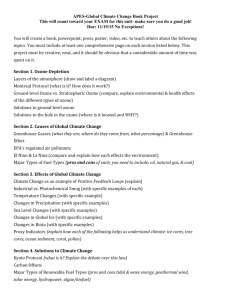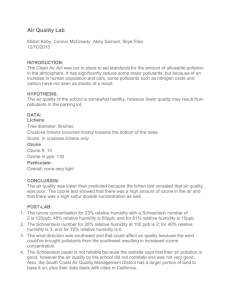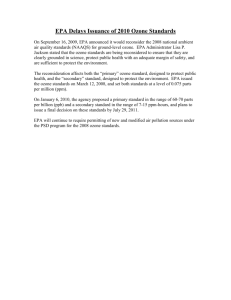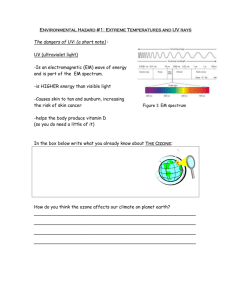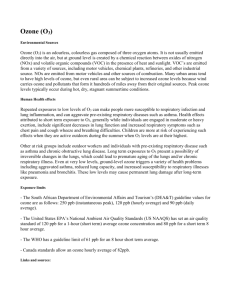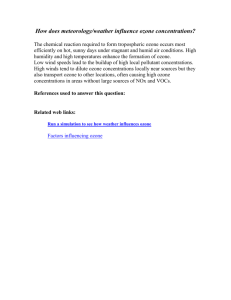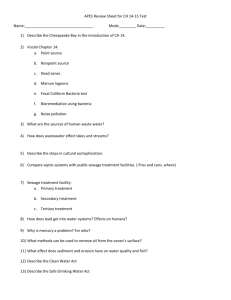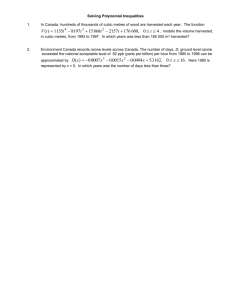Air Quality Extreme Events and Projected Trends for the Southwestern United States
advertisement
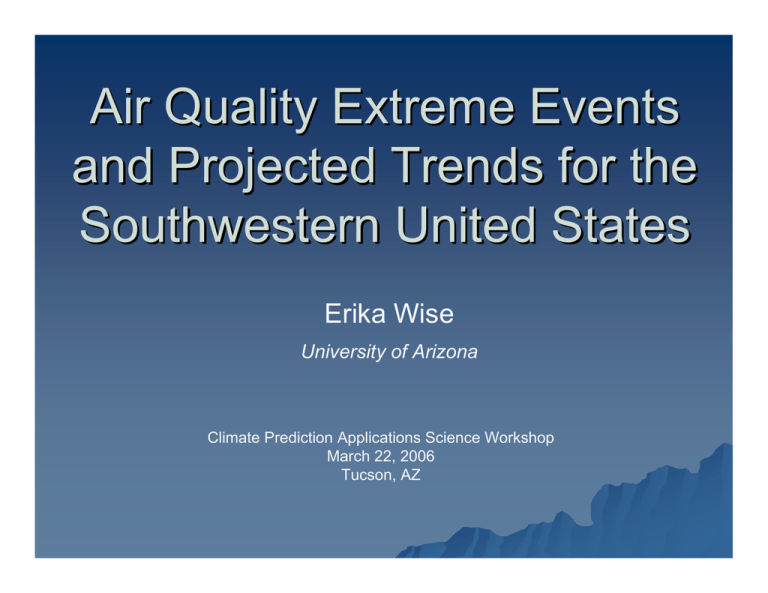
Air Quality Extreme Events and Projected Trends for the Southwestern United States Erika Wise University of Arizona Climate Prediction Applications Science Workshop March 22, 2006 Tucson, AZ Project Context Established to assess impacts of climate variability and change on human and natural systems in the Southwest Air quality initiative: help air quality planners and managers understand links between climate and pollutants to improve decision-making capabilities Central Phoenix Station, Phoenix, AZ Previous study: meteorologicallyadjusted, long-term trends (Wise and Comrie 2005) Model 1 ( - Temp) Model 2 ( - Temp/MH) Model 3 ( -Temp/MH/AWND) Unadjusted Long-Term Ozone 51 49 47 Ozone (ppb) 53 45 43 41 39 37 35 33 1991 1992 1993 1994 1995 1996 Year 1997 1998 1999 2000 2001 Research Needs Focus on ozone and PM – NAAQS regulations – Known detrimental effects (health, environment, visibility) Source: Liverman and Merideth 2002 Cities in the Southwest are often close to violating federal standards – Local climate and weather conditions often determine whether levels are exceeded Probabilities of exceedances, now and in the future Objectives Meet research needs regarding extreme events and future conditions by: Characterizing ozone and PM air quality exceedances under current conditions using extreme value methods Downscaling climate model scenarios to determine probable changes in ozone/PM meteorology and resulting changes in return levels Background: Predicted Changes Climate – Warmer: 5-6°C projected for West by 2100 – Less certainty with precipitation; more model-dependent Temperature Air quality – Ozone-focused – Globally: uncertain – Western US: higher ozone (Prather et al. 2002; Leung and Gustafson 2005) Precipitation www.usgcrp.gov Data Ozone and PM data – Local, state, and federal environmental agencies – Ozone: maximum daily 8-hr average – PM: 24-hour average PM10 GCM scenarios: Hadley Centre’s HadCM3; SRES A2 and B2 scenarios NCEP reanalysis meteorological variables Tucson, AZ www.ipcc.ch Methods: Extreme Values Central Limit vs. Extreme Types Theorem – Normal vs. GEV/GP distributions Used to estimate: – Return Period that threshold is exceeded in a given time period – Return Level Magnitude of the return period Applied using R-source ExtRemes (Gilleland and Katz 2004 / NCAR) www.isse.ucar.edu Probability Methods: Statistical DownScaling Model (SDSM - Wilby et al. 2002) Combines stochastic weather generator and regression-based approaches Model calibrated using observational predictors / predictand Modeled relationships and GCM predictors generate future scenarios 1990-2001 / 2002-2050 / 2051-2099 www-esd.lbl.gov Results: Observed Extremes Shape parameter = -0.24 (beta) Shape parameter = 0.12 (Pareto) Results: Ozone Return Levels (Current Conditions) Return Period (yrs) Return Level (ppb) Confidence Interval (ppb) 1 81 80-82 10 86 85-89 100 90 87-93 Results: PM Return Levels (Current Conditions) Return Period (yrs) Return Level (µg/m3) Confidence Interval (µg/m3) 1 100 93-109 10 146 128-167 100 207 173-241 Results: SDSM Calibration and Verification Calibration: 1990-1995 – Observed predictand (ozone/PM) and NCEP climate predictors Verification: 1996-2001 – Observed and modeled output NCEP Predictor Variables Tucson Ozone Tucson PM 500 hPa divergence Mean sea level pressure 850 hPa airflow strength 500 hPa geopotential height Relative humidity at 500hPa Relative humidity at 850hPa Near surface relative humidity Near surface relative humidity Surface specific humidity Mean temp at 2m 2 R 0.348 0.277 Results: Modeled Future Ozone 70 70 Dec Nov Oct Sep Jan Dec Maximum Ozone 10 A2 2051-2099 B2 2051-2099 ppb 5 www.ipcc.ch Nov Oct Sep Aug Jul 30 Jun 30 May 40 Apr 40 Mar 50 Feb 50 Aug 60 Jul 60 Jun ppb 80 May Baseline 80 Jan B2 Baseline 90 Apr 90 ppb 100 B2 Mar 100 Maximum Ozone 2051-2099 Feb Mean Ozone 2051-2099 0 -5 -10 Winter Spring Summer Autumn Results: Modeled Future PM Mean PM 2002-2050 36 34 32 32 30 30 µg/m3 34 28 26 28 26 24 B2 24 B2 22 Baseline 22 Baseline -5 -10 Jan Feb Mar Apr May Jun Jul Aug Dec Nov Oct Sep Dec 0 Aug Apr Nov B2 2051-2099 Jul Mar Oct B2 2002-2050 5 Jun Feb Sep Mean PM May Jan Dec Nov Oct Sep Aug Jul Jun 20 10 µg/m3 May Apr Mar Feb 20 Jan µg/m 3 36 Mean PM 2051-2099 Results: Modeled Ozone Extremes Return Period (yrs) 1990-2001 Return Level (CI) 2002-2050 Return Level (CI) 2051-2099 Return Level (CI) 1 79 (78-80) 81 (81-82) 87 (86-88) 10 85 (83-87) 89 (88-91) 96 (94-98) 100 88 (86-92) 95 (92-97) 103 (100-106) parts per billion 5 2002-2050 Return 2051-2099 Return Return Period Level Increase Level Increase (yrs) from Baseline from Baseline 2.53% 10.13% 10 4.71% 12.94% 100 7.95% 17.05% 4.12 4 ppb 1 Ozone Exceedances of 80 ppb Threshold per Year 3 Modeled Observed 2 1 0.75 0.98 1.16 0 1990-2001 2002-2050 Time Period 2051-2099 Results: Modeled PM Extremes Return Period (yrs) 1990-2001 Return Level (CI) 2002-2050 Return Level (CI) 2051-2099 Return Level (CI) 1 85 (79-94) 81 (79-83) 83 (82-86) 10 132 (110-155) 105 (99-115) 107 (101-114) 100 213 (168-258) 133 (118-148) 131 (120-143) 3 µg/m Conclusions Characterization of air quality exceedances under current climate conditions: Ozone: – 1-yr return period for exceedances (80 ppb) – 100-yr return level = 90 ppb PM: – 10-yr return period for exceedances (150 ug/m3) – 100-yr return level = 207 µg/m3 Conclusions Downscaled GCM projections applied to air quality: SDSM models correspond well with observed validation period air quality – Mean, max ozone – Mean PM Ozone PM – Monthly means increase 4-5 ppb in summer and autumn – Increases in summer seasonal max up to 10 ppb – Summer monthly mean increases up to 9 µg/m3 – Winter decreases (but within confidence interval) Conclusions Modeled climate influence on future extreme events: Ozone PM – Increases in return levels at 1-yr (10%), 10-yr (13%), and 100-yr (17%) return periods by 2099 – Quadrupling of exceedance rate/yr by 2099 – Projected decreases from 1990-2001 to 20022050 – No change 2002-2050 to 2051-2099 – 21st-century 100-yr return levels below NAAQS Future Research Compare return levels and climate sensitivity with other Southwest cities Modification of PM calibration period, statistical methods, or threshold for better simulation of extremes Incorporation of emissions scenarios / chemical transport seattlepi.nwsource.com Thank You! Acknowledgments: – – – – – Climate Assessment for the Southwest project National Oceanic and Atmospheric Administration Dr. Andrew Comrie Pima Department of Environmental Quality National Center for Atmospheric Research Image source: Gregg Townsend
